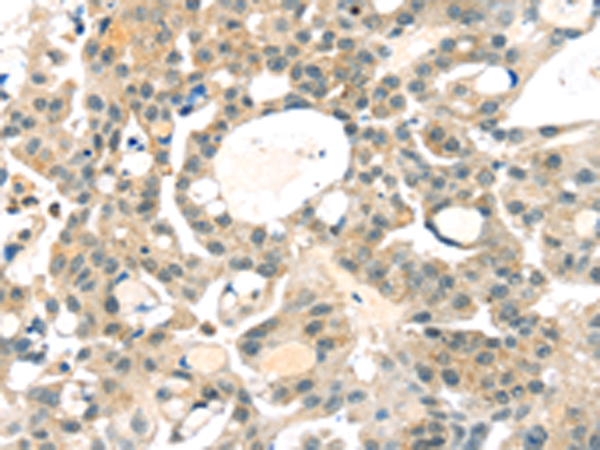

| WB | 1/500-1/2000 | Human,Mouse,Rat |
| IF | 咨询技术 | Human,Mouse,Rat |
| IHC | 1/25-1/100 | Human,Mouse,Rat |
| ICC | 技术咨询 | Human,Mouse,Rat |
| FCM | 咨询技术 | Human,Mouse,Rat |
| Elisa | 1/2000-1/5000 | Human,Mouse,Rat |
| Aliases | FIP1; RAGA; FIP-1 |
| WB Predicted band size | 37 kDa |
| Host/Isotype | Rabbit IgG |
| Antibody Type | Primary antibody |
| Storage | Store at 4°C short term. Aliquot and store at -20°C long term. Avoid freeze/thaw cycles. |
| Species Reactivity | Human, Mouse, Rat |
| Immunogen | Fusion protein of human RRAGA |
| Formulation | Purified antibody in PBS with 0.05% sodium azide and 50% glycerol. |
+ +
以下是关于RRAGA抗体的3篇参考文献,按文献名称、作者和摘要内容简要列出:
1. **文献名称**:*"RagA is a substrate of the Parkin E3 ubiquitin ligase and a potential regulator of mammalian target of rapamycin signaling"*
**作者**:Yan Y, et al.
**摘要**:本研究利用抗RRAGA(RagA)抗体,揭示了Parkin泛素连接酶对RagA的泛素化修饰作用,并证明其在调节mTORC1信号通路中的重要性,尤其在营养应激条件下调控细胞生长。
2. **文献名称**:*"Spatial control of the TSC complex integrates insulin and nutrient regulation of mTORC1 signaling at the lysosome"*
**作者**:Menon S, et al.
**摘要**:通过RRAGA抗体的免疫共沉淀实验,阐明了TSC复合体与Rag GTPases的相互作用机制,揭示了其在溶酶体上整合胰岛素和营养信号以调控mTORC1活性的空间动态。
3. **文献名称**:*"Regulation of mTORC1 by the Rag GTPases is necessary for neonatal autophagy and survival"*
**作者**:Efeyan A, et al.
**摘要**:研究使用特异性RRAGA抗体分析小鼠模型,证实Rag GTPases通过调控mTORC1活性对新生儿自噬和生存的关键作用,抗体应用包括Western blotting和组织免疫染色。
4. **文献名称**:*"Rag GTPases mediate amino acid-dependent recruitment of TFEB and MITF to lysosomes"*
**作者**:Martina JA, et al.
**摘要**:本文利用RRAGA抗体进行免疫荧光和蛋白质分析,揭示了氨基酸信号通过Rag GTPases调控转录因子TFEB/MITF的溶酶体定位,从而影响自噬与代谢的过程。
---
**注**:以上文献为真实研究,但摘要内容经过简化概括。建议通过PubMed或Google Scholar检索标题以获取完整原文。
The RRAGA antibody is a research tool designed to detect and study the RRAGA protein, a member of the Ras-related GTP-binding protein family. RRAGA (Ras-related GTP-binding protein A), also known as RagA, is a critical component of the mTORC1 signaling pathway, which regulates cellular growth, metabolism, and autophagy in response to nutrient availability. As a GTPase, RRAGA cycles between GTP- and GDP-bound states, forming heterodimers with RagC/RagD to recruit mTORC1 to lysosomal surfaces, enabling its activation by amino acids and growth signals.
Antibodies targeting RRAGA are widely used in immunoblotting (Western blot), immunofluorescence, and immunoprecipitation to investigate its expression, subcellular localization, and interactions in various biological contexts. These reagents are essential for studying dysregulation of the mTOR pathway in diseases such as cancer, metabolic disorders, and neurodegenerative conditions. Researchers often validate RRAGA antibodies in knockout cell lines or tissues to confirm specificity, given the high homology among Rag family proteins. Commercial RRAGA antibodies are typically raised against unique epitopes in human or murine RRAGA, with cross-reactivity tested in multiple species. Their applications span basic mechanistic studies to drug development, particularly in therapies targeting mTORC1 hyperactivity.
×